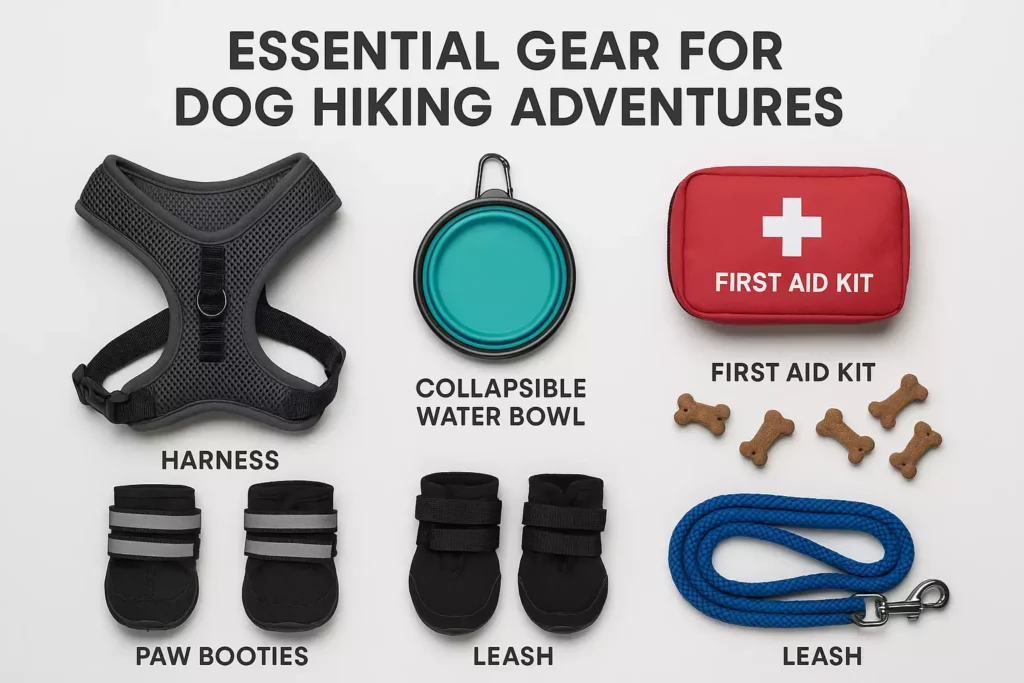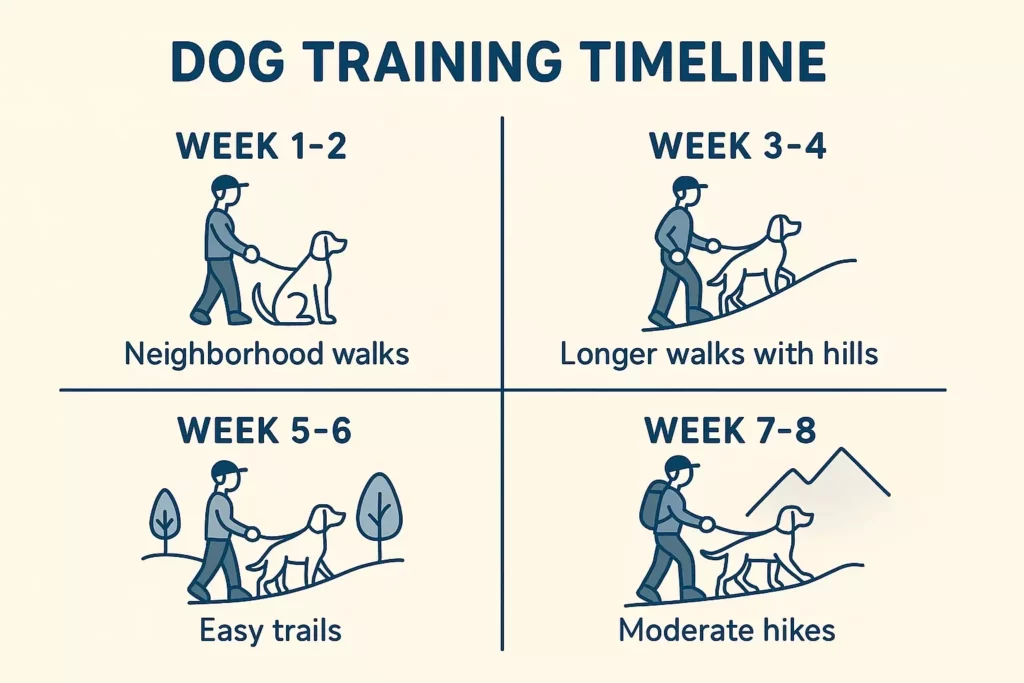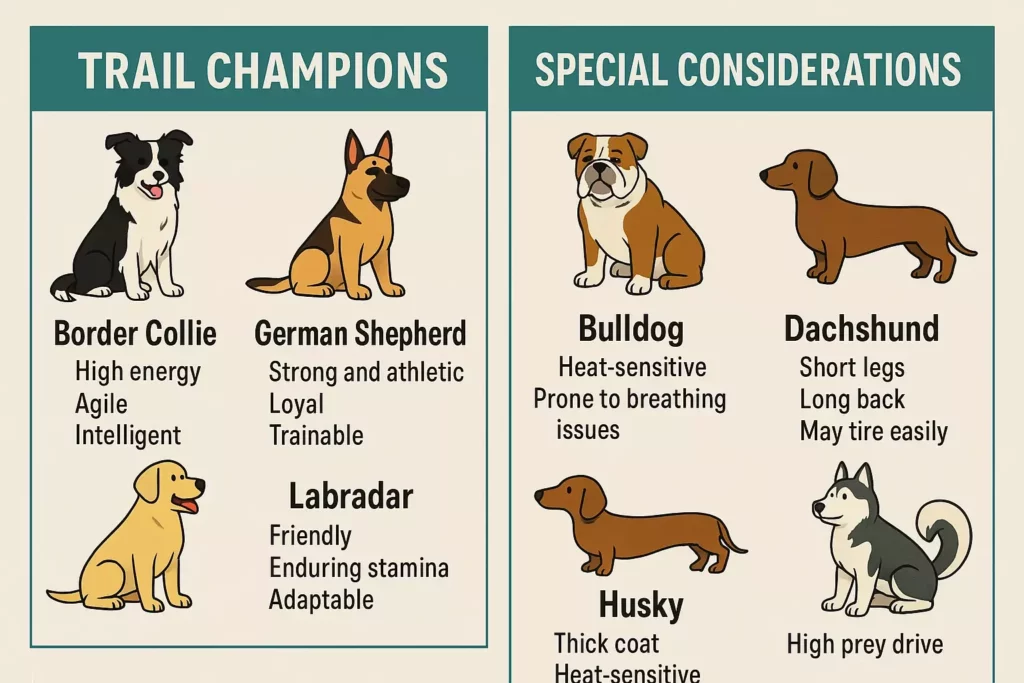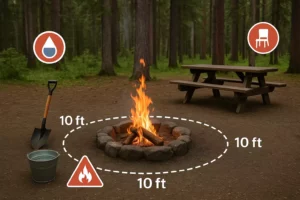How to Prep Your Pup for the Trail: A Beginner’s Guide to Hiking with Dogs
Picture this: you’re standing at the trailhead, backpack loaded and hiking boots laced, when your furry companion bounds ahead with unbridled enthusiasm. But wait—is your dog actually ready for what lies ahead? While that excitement is heartwarming, taking your four-legged friend on mountain trails requires more preparation than simply clipping on a leash and heading out.

Hiking with dogs can be one of life’s most rewarding outdoor experiences, creating unforgettable memories while strengthening the bond between you and your canine companion. However, successful dog hiking adventures don’t happen by accident. They require careful planning, proper gear, and a well-conditioned pup who’s ready to tackle everything from rocky terrain to unpredictable weather.
Key Takeaways
- Start with short, easy trails and gradually build your dog’s endurance over several weeks
- Essential gear includes a proper harness, collapsible water bowl, first aid supplies, and paw protection
- Physical conditioning and basic obedience training are crucial before attempting challenging mountain trails
- Weather awareness and trail etiquette ensure safe, enjoyable experiences for everyone on the trail
- Post-hike care and monitoring help prevent injuries and keep your dog healthy for future adventures
Understanding Your Dog’s Hiking Readiness
Age and Physical Development Considerations
Not all dogs are born trail-ready. Puppies under 18 months should avoid strenuous hiking, as their joints and growth plates are still developing. Large breed dogs may need to wait even longer—up to 24 months—before tackling demanding mountain terrain.
Senior dogs (typically 7+ years, depending on breed) can still enjoy hiking but may require shorter distances and more frequent breaks. Watch for signs of arthritis, decreased stamina, or difficulty navigating uneven surfaces.
Breed-Specific Factors
Different breeds have varying hiking capabilities:
🏔️ Natural Trail Champions:
- Border Collies
- Australian Shepherds
- Siberian Huskies
- German Shepherds
- Labrador Retrievers
⚠️ Breeds Requiring Extra Caution:
- Brachycephalic breeds (Bulldogs, Pugs) – breathing difficulties
- Dachshunds – back injury risks on rocky terrain
- Great Danes – joint stress from their size
- Arctic breeds in hot climates – overheating risks
Health Clearance and Vet Consultation
Before hitting the trails, schedule a veterinary checkup to ensure your dog is physically ready for hiking adventures. Discuss any concerns about joint health, cardiovascular fitness, or existing medical conditions that might impact trail performance.
Essential Pre-Hike Training and Conditioning

Building Physical Endurance
Week 1-2: Foundation Building
Start with 15-20 minute neighborhood walks on varied terrain. Gradually introduce inclines using local hills or park trails.
Week 3-4: Distance Expansion
Increase walks to 30-45 minutes, adding light backpack weight (no more than 10% of your dog’s body weight).
Week 5-6: Trail Simulation
Practice on easy local trails with natural obstacles like fallen logs, stream crossings, and rocky patches.
Week 7-8: Advanced Preparation
Attempt longer hikes (2-3 hours) on moderate terrain to assess your dog’s true hiking readiness.
Obedience Training for Trail Safety
Critical Commands for Hiking:
- “Wait” – Stops your dog before dangerous terrain
- “Leave it” – Prevents consumption of harmful plants or wildlife scat
- “Close” – Brings your dog near when other hikers approach
- “Easy” – Slows pace on steep or technical sections
Practice these commands in distracting environments to ensure reliability on busy trails.
Gear Essentials for Hiking with Dogs
Harnesses and Leash Systems
Front-clip harnesses provide better control on steep terrain while reducing neck strain. Look for padded chest plates and adjustable straps for comfort during long hikes.
Hands-free leash systems allow natural arm movement while maintaining control. Choose options with bungee sections to absorb sudden pulls.
Hydration and Nutrition
Collapsible silicone bowls pack small and provide easy drinking access at water sources. Bring 1 ounce of water per pound of dog weight for hikes over 2 hours.
High-energy treats help maintain blood sugar on longer trails. Avoid feeding large meals within 2 hours of hiking to prevent bloat.
Protection and Safety Gear
Paw Protection Options:
- Booties for rocky or hot terrain
- Paw wax for moderate protection
- Musher’s Secret for paw conditioning
Visibility and Identification:
- Bright-colored harness or vest
- Updated ID tags with emergency contact
- Consider GPS tracking collars for off-leash areas
Just as you would pack essential first aid supplies for yourself, create a canine-specific emergency kit including bandages, antiseptic wipes, and any medications your dog requires.
Trail Selection and Planning

Choosing Dog-Friendly Trails
Beginner-Friendly Features:
- Well-maintained paths with minimal elevation gain
- Natural water sources for hydration
- Shaded sections for hot weather hiking
- Loop trails to avoid retracing steps
Red Flags to Avoid:
- Trails with technical rock scrambling
- Areas with known wildlife conflicts
- Paths crossing busy roads
- Extremely exposed routes without shade
Weather Considerations
Hot Weather Precautions (Above 75°F):
- Start hiking at dawn to avoid peak heat
- Choose shaded, high-elevation trails
- Bring extra water and electrolyte supplements
- Watch for signs of overheating (excessive panting, drooling)
Cold Weather Preparations:
- Consider appropriate cold-weather gear for both you and your dog
- Protect paws from ice and salt with booties
- Shorter daylight hours require earlier starts
- Pack emergency warming supplies
Distance and Duration Guidelines
| Dog’s Experience Level | Recommended Distance | Duration | Elevation Gain |
|---|---|---|---|
| Beginner | 2-4 miles | 2-3 hours | Under 500 feet |
| Intermediate | 4-8 miles | 3-5 hours | 500-1,500 feet |
| Advanced | 8+ miles | 5+ hours | 1,500+ feet |
Trail Etiquette and Safety
Leash Laws and Wildlife Encounters
Most trail systems require dogs to remain leashed for wildlife protection and hiker safety. Even well-trained dogs can chase wildlife or become defensive around unfamiliar people.
Wildlife Safety Protocol:
- Make noise in bear country to avoid surprise encounters
- Keep dogs close when spotting wildlife
- Never allow dogs to chase or harass animals
- Carry bear spray in appropriate regions
Interaction with Other Hikers
Proper Trail Courtesy:
- Step aside to let faster hikers pass
- Keep dogs under control around other trail users
- Clean up all waste and pack it out
- Respect “no dogs” areas and seasonal restrictions
“The best hiking companions are those who leave no trace and respect the natural environment for future generations.”
Emergency Preparedness
Develop an emergency action plan including:
- Emergency contact information for local veterinarians
- Knowledge of nearest road access points
- Basic first aid skills for both humans and dogs
- Communication devices for remote areas
On-Trail Best Practices

Pacing and Rest Management
Signs Your Dog Needs a Break:
- Heavy panting with tongue fully extended
- Lagging behind or reluctant to continue
- Seeking shade or lying down frequently
- Excessive drooling or glazed expression
Plan rest stops every 45-60 minutes, allowing your dog to cool down and rehydrate. Use these breaks to check paws for cuts, thorns, or excessive wear.
Hydration and Nutrition Timing
Offer water every 30 minutes, even if your dog doesn’t seem thirsty. Dogs don’t regulate body temperature as efficiently as humans and can become dehydrated quickly.
Feeding Schedule:
- Light breakfast 2-3 hours before hiking
- Small, high-energy snacks every 2 hours on trail
- Avoid large meals until after the hike
Navigation and Route Finding
Keep your dog close during navigation challenges. Excited dogs may take wrong turns at trail junctions or become separated in dense forest areas.
Use consistent verbal cues to signal direction changes and maintain your dog’s attention during technical sections.
Post-Hike Care and Recovery
Immediate Post-Hike Assessment
Physical Inspection Checklist:
- ✅ Check paws for cuts, thorns, or swelling
- ✅ Examine legs and joints for signs of strain
- ✅ Look for ticks, especially around ears and neck
- ✅ Monitor breathing and energy levels
- ✅ Ensure adequate water intake
Recovery and Rest
Allow 24-48 hours of light activity after challenging hikes. Watch for delayed signs of overexertion including:
- Stiffness or limping
- Loss of appetite
- Excessive sleeping
- Behavioral changes
Building a Hiking Routine
Start with weekly hikes, gradually increasing frequency as your dog’s fitness improves. Keep a hiking log to track distances, conditions, and your dog’s performance for future planning.
Just as you might plan family camping activities to build outdoor skills, consistent hiking builds your dog’s trail confidence and physical capabilities.
Advanced Tips for Experienced Dog Hikers
Multi-Day Backpacking Considerations
Once your dog masters day hikes, overnight adventures become possible with additional preparation:
Gear Additions:
- Lightweight sleeping pad for your dog
- Portable dog food and feeding supplies
- Extended first aid kit
- Weather protection gear
Learn from experienced backpackers about proper packing techniques that can be adapted for carrying dog supplies.
Seasonal Hiking Adaptations
Spring Challenges:
- Muddy trails and stream crossings
- Increased tick activity
- Unpredictable weather changes
Summer Strategies:
- Early morning starts to avoid heat
- Higher elevation trails for cooler temperatures
- Extra water and electrolyte planning
Fall Preparations:
- Shorter daylight hours
- Slippery leaves on trail surfaces
- Hunting season awareness and safety
Winter Considerations:
- Paw protection from ice and salt
- Hypothermia prevention
- Avalanche awareness in mountain regions
Building Trail Confidence
Progressive Challenge System:
- Master local easy trails
- Introduce new terrain types gradually
- Practice technical skills in controlled environments
- Build up to goal destinations over time
This systematic approach mirrors successful camping preparation strategies that build confidence through gradual skill development.
🐕 Dog Hiking Readiness Assessment
Answer these questions to determine your dog’s hiking experience level and get personalized recommendations
1. What is your dog’s age?
2. How often does your dog currently exercise?
3. How well does your dog respond to basic commands?
4. What is your dog’s hiking experience?
5. How does your dog handle new environments?
Recommended Next Steps:
Conclusion
Hiking with your dog opens up a world of outdoor adventures that strengthen your bond while providing excellent exercise for both of you. Success starts with honest assessment of your dog’s readiness, proper conditioning, and the right gear for trail safety.
Remember that every dog progresses at their own pace. What matters most is building confidence gradually while prioritizing safety and enjoyment. Start with easy local trails, master the basics, and slowly work toward more challenging mountain adventures.
Your Next Steps:
- Assess your dog’s current fitness level using the guidelines provided
- Begin a structured conditioning program 6-8 weeks before your first major hike
- Invest in essential safety gear including proper harness, first aid supplies, and paw protection
- Practice trail commands in various environments until they become second nature
- Plan your first hiking adventure on a beginner-friendly trail with backup exit options
The trail is calling, and with proper preparation, you and your four-legged hiking partner will be ready to answer. Whether you’re planning a simple day hike or dreaming of multi-day backpacking adventures, the foundation you build now will support years of incredible outdoor memories together.
Start small, stay safe, and most importantly—have fun exploring the great outdoors with your best hiking buddy by your side! 🐕🥾






